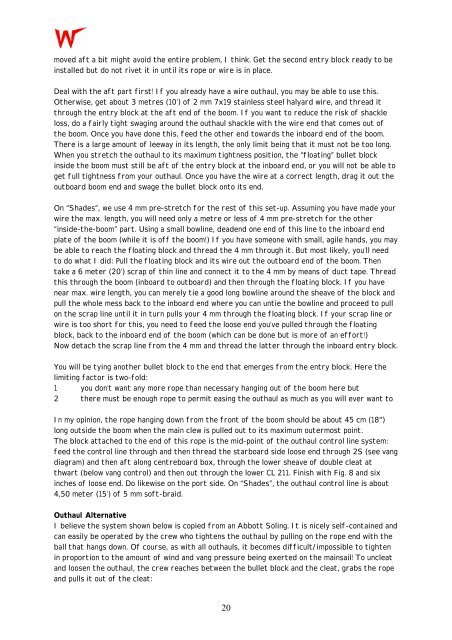File - Canadian Wayfarer Association
File - Canadian Wayfarer Association
File - Canadian Wayfarer Association
You also want an ePaper? Increase the reach of your titles
YUMPU automatically turns print PDFs into web optimized ePapers that Google loves.
moved aft a bit might avoid the entire problem, I think. Get the second entry block ready to be<br />
installed but do not rivet it in until its rope or wire is in place.<br />
Deal with the aft part first! If you already have a wire outhaul, you may be able to use this.<br />
Otherwise, get about 3 metres (10’) of 2 mm 7x19 stainless steel halyard wire, and thread it<br />
through the entry block at the aft end of the boom. If you want to reduce the risk of shackle<br />
loss, do a fairly tight swaging around the outhaul shackle with the wire end that comes out of<br />
the boom. Once you have done this, feed the other end towards the inboard end of the boom.<br />
There is a large amount of leeway in its length, the only limit being that it must not be too long.<br />
When you stretch the outhaul to its maximum tightness position, the “floating” bullet block<br />
inside the boom must still be aft of the entry block at the inboard end, or you will not be able to<br />
get full tightness from your outhaul. Once you have the wire at a correct length, drag it out the<br />
outboard boom end and swage the bullet block onto its end.<br />
On “Shades”, we use 4 mm pre-stretch for the rest of this set-up. Assuming you have made your<br />
wire the max. length, you will need only a metre or less of 4 mm pre-stretch for the other<br />
“inside-the-boom” part. Using a small bowline, deadend one end of this line to the inboard end<br />
plate of the boom (while it is off the boom!) If you have someone with small, agile hands, you may<br />
be able to reach the floating block and thread the 4 mm through it. But most likely, you’ll need<br />
to do what I did: Pull the floating block and its wire out the outboard end of the boom. Then<br />
take a 6 meter (20’) scrap of thin line and connect it to the 4 mm by means of duct tape. Thread<br />
this through the boom (inboard to outboard) and then through the floating block. If you have<br />
near max. wire length, you can merely tie a good long bowline around the sheave of the block and<br />
pull the whole mess back to the inboard end where you can untie the bowline and proceed to pull<br />
on the scrap line until it in turn pulls your 4 mm through the floating block. If your scrap line or<br />
wire is too short for this, you need to feed the loose end you’ve pulled through the floating<br />
block, back to the inboard end of the boom (which can be done but is more of an effort!)<br />
Now detach the scrap line from the 4 mm and thread the latter through the inboard entry block.<br />
You will be tying another bullet block to the end that emerges from the entry block. Here the<br />
limiting factor is two-fold:<br />
1 you don’t want any more rope than necessary hanging out of the boom here but<br />
2 there must be enough rope to permit easing the outhaul as much as you will ever want to<br />
In my opinion, the rope hanging down from the front of the boom should be about 45 cm (18")<br />
long outside the boom when the main clew is pulled out to its maximum outermost point.<br />
The block attached to the end of this rope is the mid-point of the outhaul control line system:<br />
feed the control line through and then thread the starboard side loose end through 2S (see vang<br />
diagram) and then aft along centreboard box, through the lower sheave of double cleat at<br />
thwart (below vang control) and then out through the lower CL 211. Finish with Fig. 8 and six<br />
inches of loose end. Do likewise on the port side. On “Shades”, the outhaul control line is about<br />
4,50 meter (15’) of 5 mm soft-braid.<br />
Outhaul Alternative<br />
I believe the system shown below is copied from an Abbott Soling. It is nicely self-contained and<br />
can easily be operated by the crew who tightens the outhaul by pulling on the rope end with the<br />
ball that hangs down. Of course, as with all outhauls, it becomes difficult/impossible to tighten<br />
in proportion to the amount of wind and vang pressure being exerted on the mainsail! To uncleat<br />
and loosen the outhaul, the crew reaches between the bullet block and the cleat, grabs the rope<br />
and pulls it out of the cleat:<br />
20


